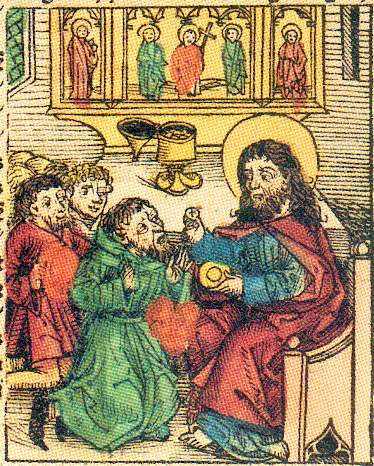This idea may have had its origin in third-hand stories about Ethiopia. That region of east Africa included a large Christian population (the kingdom of Ethiopia had made Christianity the official religion in the fourth century) and a large Jewish population. The latter were descended, according to legend, from the Queen of Sheba, who had married King Solomon. The Prester John of the stories was usually black (like the Ethiopians) and also Christian.
But there was more to the story of Prester John than confused travelers' tales about Ethiopia (or India or Christian Armenia). The story gained wide currency from the (fictive) accounts in a volume called Mandeville's Travels. Mandeville supposedly discovered two great kingdoms, side by side in Africa (or India, or possibly the Middle East, at any rate very far away), one a scary Muslim kingdom of Assassins, the other a beautiful and happy Christian kingdom ruled over by Prester John. In some versions, John was descended from the Three Magi. Thus tales of Prester John, who combined the functions of king and priest, could serve as a foil for all that was supposedly bad about Islam.
The kingdom of Prester John was of course opulent, full of rich jewels, as any imagined wonderful country should be. But John and his nobles lived abstemiously, eating simple fare, having sex only a few times a year and then only for the purpose of procreation. Prester John got to have a harem in these stories, or at least be polygamous like an Old Testament figure, but he rarely visited his wives. Thus the stories about him could also serve as morality stories about what Europe's own monarchs were supposed to be like, as seen in the late medieval image below. The supposed Assassin kingdom next door to Prester John's, in contrast, was full of gluttony and lechery.

It should not be a surprise that stories of Prester John first became popular in the middle of the twelfth century, during the height of the crusading movement. A letter that he supposedly wrote, saying that he wanted to help defend Jerusalem from the Muslims and personally visit the Holy Sepulchre, gained wide circulation in the 1140s. In the 1170s the pope wrote a letter to Prester John, suggesting they should work together, though he doesn't seem to have gotten an answer.
In the early thirteenth century, after the Muslims had taken back Jerusalem, a crusading army made some spectacularly disastrous strategic decisions based on the conviction that Prester John himself (or a son or grandson or nephew for sure) was about to show up with his armies to help them. (As you probably guessed, he didn't.)
The story of Prester John continued to be influential during the late Middle Ages, getting extra impetus when diplomatic relations were established (sort of) with Ethiopia in the fourteenth century. By the seventeenth century, however, Europeans had to admit that perhaps Prester John had not been real after all, and that Ethiopia was not the marvelous jeweled kingdom they'd heard about.
© C. Dale Brittain 2020
For more on crusades and legends and other aspects of medieval history, see my ebook, Positively Medieval: Life and Society in the Middle Ages, available on Amazon and other e-tailers. Also available as a paperback.

No comments:
Post a Comment